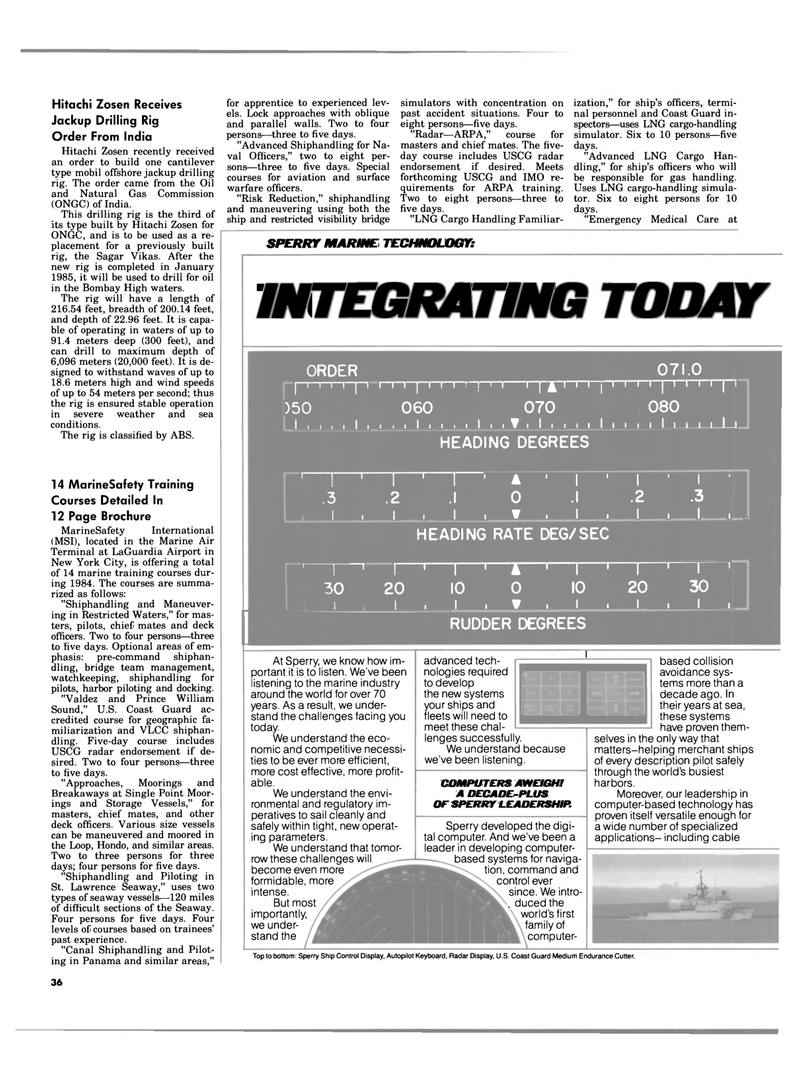
Page 34: of Maritime Reporter Magazine (August 1984)
Read this page in Pdf, Flash or Html5 edition of August 1984 Maritime Reporter Magazine
Hitachi Zosen Receives
Jackup Drilling Rig
Order From India
Hitachi Zosen recently received an order to build one cantilever type mobil offshore jackup drilling rig. The order came from the Oil and Natural Gas Commission (ONGC) of India.
This drilling rig is the third of its type built by Hitachi Zosen for
ONGC, and is to be used as a re- placement for a previously built rig, the Sagar Vikas. After the new rig is completed in January 1985, it will be used to drill for oil in the Bombay High waters.
The rig will have a length of 216.54 feet, breadth of 200.14 feet, and depth of 22.96 feet. It is capa- ble of operating in waters of up to 91.4 meters deep (300 feet), and can drill to maximum depth of 6,096 meters (20,000 feet). It is de- signed to withstand waves of up to 18.6 meters high and wind speeds of up to 54 meters per second; thus the rig is ensured stable operation in severe weather and sea conditions.
The rig is classified by ABS. 14 MarineSafety Training
Courses Detailed In 12 Page Brochure
MarineSafety International (MSI), located in the Marine Air
Terminal at LaGuardia Airport in
New York City, is offering a total of 14 marine training courses dur- ing 1984. The courses are summa- rized as follows: "Shiphandling and Maneuver- ing in Restricted Waters," for mas- ters, pilots, chief mates and deck officers. Two to four persons—three to five days. Optional areas of em- phasis: pre-command shiphan- dling, bridge team management, watchkeeping, shiphandling for pilots, harbor piloting and docking. "Valdez and Prince William
Sound," U.S. Coast Guard ac- credited course for geographic fa- miliarization and VLCC shiphan- dling. Five-day course includes
USCG radar endorsement if de- sired. Two to four persons—three to five days. "Approaches, Moorings and
Breakaways at Single Point Moor- ings and Storage Vessels," for masters, chief mates, and other deck officers. Various size vessels can be maneuvered and moored in the Loop, Hondo, and similar areas.
Two to three persons for three days; four persons for five days. "Shiphandling and Piloting in
St. Lawrence Seaway," uses two types of seaway vessels—120 miles of difficult sections of the Seaway.
Four persons for five days. Four levels of courses based on trainees' past experience. "Canal Shiphandling and Pilot- ing in Panama and similar areas," for apprentice to experienced lev- els. Lock approaches with oblique and parallel walls. Two to four persons—three to five days. "Advanced Shiphandling for Na- val Officers," two to eight per- sons—three to five days. Special courses for aviation and surface warfare officers. "Risk Reduction," shiphandling and maneuvering using both the ship and restricted visibility bridge simulators with concentration on past accident situations. Four to eight persons—five days. "Radar—ARPA," course for masters and chief mates. The five- day course includes USCG radar endorsement if desired. Meets forthcoming USCG and IMO re- quirements for ARPA training.
Two to eight persons—three to five days. "LNG Cargo Handling Familiar- ization," for ship's officers, termi- nal personnel and Coast Guard in- spectors—uses LNG cargo-handling simulator. Six to 10 persons—five days. "Advanced LNG Cargo Han- dling," for ship's officers who will be responsible for gas handling.
Uses LNG cargo-handling simula- tor. Six to eight persons for 10 days. "Emergency Medical Care at
SPERRY MARINE TECHNOLOGY:
INTEGRATING TODAY
ORDER 071.0 , . . . i | i )50 l i i i i I i 1 1 1 | ! ! ! I | 1 1 1 | ± 1 1 1 | 1 « 1 1 j 1 » 1 1 j 1 060 070 080 i . i 1 i 1 . 1 1 i i • 1 1 1 t I . 1 . 1 1 . 1 Ll 1 1 1 1
HEADING DEGREES i | . | . | , A , , , , . , • .3 .2 .1 0 .1 .2 .3 1 , 1 , 1 ,¥.1.1.1.-
HEADING RATE DEG/SEC 1 1 ' 30 . i 1 i 1 i 4 i 1 i 1 > 1 i 20 10 0 10 20 30 1 , 1 . V . 1 . 1 . 1 .i. | RUDDER DEGREES
At Sperry, we know how im- portant it is to listen. We've been listening to the marine industry around the world for over 70 years. As a result, we under- stand the challenges facing you today.
We understand the eco- nomic and competitive necessi- ties to be ever more efficient, more cost effective, more profit- able.
We understand the envi- ronmental and regulatory im- peratives to sail cleanly and safely within tight, new operat- ing parameters.
We understand that tomor- row these challenges will become even more formidable, more intense.
But most importantly, we under- stand the advanced tech- nologies required to develop the new systems your ships and fleets will need to meet these chal- lenges successfully.
We understand because we've been listening.
COMPUTERS AWEIGHF
A DECADE-PLUS
OF SPERRY LEADERSHIP.
I
Sperry developed the digi- tal computer. And we've been a leader in developing computer- based systems for naviga- tion, command and control ever since. We intro- . duced the world's first family of computer- based collision avoidance sys- tems more than a decade ago. In their years at sea, these systems have proven them- selves in the only way that matters-helping merchant ships of every description pilot safely through the world's busiest harbors.
Moreover, our leadership in computer-based technology has proven itself versatile enough for a wide number of specialized applications- including cable
Top to bottom: Sperry Ship Control Display, Autopilot Keyboard, Radar Display, U.S. Coast Guard Medium Endurance Cutter. 36

 33
33

 35
35
